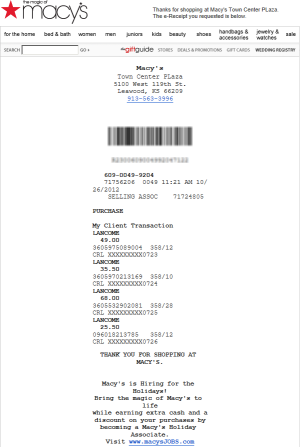Why Sending Receipts Via Email Is A Good Idea
I recently read an article about advances in the technology associated with printed receipts, their benefit as a transactional record, and the relative limits of moving to a hand-held transactional device. What that piece missed, however, was the huge value to retailers of emailing a receipt to customers who have made an in-store purchase. There […]
I recently read an article about advances in the technology associated with printed receipts, their benefit as a transactional record, and the relative limits of moving to a hand-held transactional device.
What that piece missed, however, was the huge value to retailers of emailing a receipt to customers who have made an in-store purchase. There are many benefits to this triggered email, which, up until now, has not been widely embraced during the in-store checkout experience.
1. Acquisition
If a customer chooses to receive their receipt via an email, your brand gains the opportunity to ask the customer for an opt-in to marketing emails. Due to the higher engagement rates of triggered sends, this strategy makes a great acquisition tactic. While the majority of the email must remain transactional in nature, you do have the opportunity to promote the benefits of opting in (if the subscriber has not already done so).
Sending receipts also gives retailers another reason for collecting an email address, rather than only offering a discount in return. One of the benefits to the customer of receiving and storing the receipt in their email (essentially on a mobile device) is that it makes it easy to locate later if it is necessary for a return. Rather than digging through a handbag or wallet to locate it, or wondering if it was already thrown away in the trash, a customer can simply return to their email for the digital copy.
2. Tracking
One of the biggest advantages of email is the ability to track the customer’s actions. Many receipts include a bounce-back offer for completing a survey online. If this call-to-action was included in the receipt email, I strongly believe the conversion rates would be higher.
When a customer checks email, they are already in a digital experience, making the conversion action nearly seamless. It is far less work to click a link, than to pull out a paper receipt and type in a URL.
3. Re-Marketing
Sending the receipt via email offers the retailer the opportunity to showcase additional information about the product(s) purchased, showcase accessories, or market other items purchased by customers with similar profiles.
Furthermore, it can establish the trigger to send an email to request a rating and review of the product. That email will drive traffic to your website, increasing brand awareness and creating a multichannel customer experience. The customer may also be more amenable to liking the brand on Facebook now that they have made a purchase.
4. Data Profiles
Besides allowing you to send re-marketing emails, acquiring an email address can allow a brand to expand the customer’s profile in their data warehouse. A reverse append can identify a physical address. With these pieces of information, a match can sometimes be created in the warehouse. Add to this the purchase details, and a retailer can build out a customer profile and determine propensities of future purchases.
If a customer consistently provides their email address for purchase receipts, this piece of information becomes a unique identifier, like a loyalty rewards card. But better, because instead of asking customers to fill out a lengthy loyalty club enrollment card by hand, they participate by simply providing their email address.
Warning: Speedbumps Ahead
Granted, there are a few drawbacks. In these use cases we are assuming a customer provides the same email address at each purchase point, and consistently asks for receipts to be emailed. The retailer will need to set up an integration with their ESP to trigger the emails in near real-time. In instances where I have seen this integration completed, the content appears less-than-seamless within the email, like in this example below from Macy’s:
However, the benefits of these extra actions are numerous: so much more of the customer relationship can be tracked, the trigger campaign’s ROI specifically calculated, and the associated programs quantitatively analyzed and adjusted.
I don’t believe you can abandon all printed receipts today, but very soon offline-to-online transactional email will become more widely adopted as customers become more comfortable receiving receipts in this manner. Similar to Passbook, we’ll even soon have apps that create and store e-receipts, causing it to be the norm and not the exception.
Contributing authors are invited to create content for MarTech and are chosen for their expertise and contribution to the martech community. Our contributors work under the oversight of the editorial staff and contributions are checked for quality and relevance to our readers. MarTech is owned by Semrush. Contributor was not asked to make any direct or indirect mentions of Semrush. The opinions they express are their own.
Related stories
